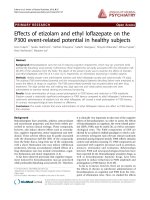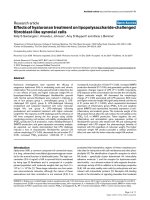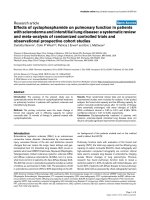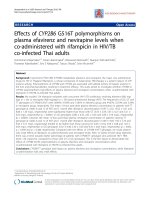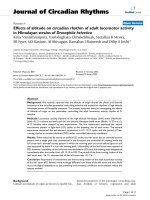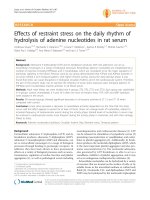Báo cáo y học: " Effects of carbohydrate, branched-chain amino acids, and arginine in recovery period on the subsequent performance in wrestlers" potx
Bạn đang xem bản rút gọn của tài liệu. Xem và tải ngay bản đầy đủ của tài liệu tại đây (523.74 KB, 46 trang )
This Provisional PDF corresponds to the article as it appeared upon acceptance. Fully formatted
PDF and full text (HTML) versions will be made available soon.
Effects of carbohydrate, branched-chain amino acids, and arginine in recovery
period on the subsequent performance in wrestlers
Journal of the International Society of Sports Nutrition 2011, 8:21 doi:10.1186/1550-2783-8-21
Tsong-Rong Jang ()
Ching-Lin Wu ()
Chai-Ming Chang ()
Wei Hung ()
Shih-Hua Fang ()
Chen-Kang Chang ()
ISSN 1550-2783
Article type Research article
Submission date 27 May 2011
Acceptance date 22 November 2011
Publication date 22 November 2011
Article URL />This peer-reviewed article was published immediately upon acceptance. It can be downloaded,
printed and distributed freely for any purposes (see copyright notice below).
Articles in JISSN are listed in PubMed and archived at PubMed Central.
For information about publishing your research in JISSN or any BioMed Central journal, go to
/>For information about other BioMed Central publications go to
/>Journal of the International
Society of Sports Nutrition
© 2011 Jang et al. ; licensee BioMed Central Ltd.
This is an open access article distributed under the terms of the Creative Commons Attribution License ( />which permits unrestricted use, distribution, and reproduction in any medium, provided the original work is properly cited.
1
Effects of carbohydrate, branched-chain amino acids, and arginine in recovery period on
the subsequent performance in wrestlers
Tsong-Rong Jang
1
, Ching-Lin Wu
2
, Chai-Ming Chang
3
, Wei Hung
4
, Shih-Hua Fang
3
,
Chen-Kang Chang
4*
Author details
1
Department of Combat Sports, National Taiwan College of Physical Education, 16, Sec
1, Shuan-Shih Rd, Taichung, 404, Taiwan.
2
Graduate Institute of Sports and Health Management, National Chung Hsing
University, 250 Kuo Kuang Road, Taichung, 402, Taiwan.
3
Institute of Athletics, National Taiwan College of Physical Education, 16, Sec 1,
Shuan-Shih Rd, Taichung, 404, Taiwan.
4
Department of Exercise Health Science, National Taiwan College of Physical
Education, 16, Sec 1, Shuan-Shih Rd, Taichung, 404, Taiwan.
4
Sport Science Research Center, National Taiwan College of Physical Education, 16,
Sec 1, Shuan-Shih Rd, Taichung, 404, Taiwan.
*
Correspondence
Chen-Kang Chang, PhD
2
Sport Science Research Center
National Taiwan College of Physical Education
16, Sec 1, Shuan-Shih Rd, Taichung 404, Taiwan
Email:
Telephone: +886-4-22213108 Ext 2210
Fax: +886-4-22256937
3
Abstract
Many athletes need to participate in multiple events in a single day. The efficient
post-exercise glycogen recovery may be critical for the performance in subsequent
exercise. This study examined whether post-exercise carbohydrate supplementation
could restore the performance in the subsequent simulated wrestling match. The effect
of branched-chain amino acids and arginine on glucose disposal and performance was
also investigated. Nine well-trained male wrestlers participated in 3 trials in a random
order. Each trial contained 3 matches with a 1-hr rest between match 1 and 2, and a 2-hr
rest between match 2 and 3. Each match contained 3 exercise periods interspersed with
1-min rests. The subjects alternated 10-s all-out sprints and 20-s rests in each exercise
period. At the end of match 2, 3 different supplementations were consumed: 1.2 g/kg
glucose (CHO trial), 1 g/kg glucose + 0.1 g/kg Arg + 0.1 g/kg BCAA (CHO+AA trial),
or water (placebo trial). The peak and average power in the 3 matches was similar in the
3 trials. After the supplementation, CHO and CHO+AA trial showed significantly
higher glucose and insulin, and lower glycerol and non-esterified fatty acid
concentrations than the placebo trial. There was no significant difference in these
biochemical parameters between the CHO and CHO+AA trials. Supplementation of
carbohydrate with or without BCAA and arginine during the post-match period had no
effect on the performance in the following simulated match in wrestlers. In addition,
4
BCAA and arginine did not provide additional insulinemic effect.
Keywords: high-intensity intermittent exercise; insulinemic; exercise performance;
exercise recovery
5
Introduction
Carbohydrate availability is one of the crucial factors for performance in
endurance [1] and high-intensity intermittent exercise [2]. It has been well-documented
that carbohydrate supplementation before a single-bout of endurance [3] and
high-intensity intermittent exercise [4] could improve the performance. In real
circumstances, many athletes undergo more than 1 training session per day. In addition,
many competitions require athletes to participate in multiple events in a single day.
Therefore, adequate nutritional strategies during the short-term post-exercise recovery
period may be critical for the performance in subsequent exercise. Several studies have
shown that ingestion of protein with carbohydrate after exercise increases muscle
glycogen resynthesis rate, compared to the same amount of carbohydrate [5, 6]. The
increased muscle glycogen recovery may lead to the improved performance during
subsequent endurance exercise [7].
Muscle glycogen resynthesis after exercise consists of two phases. The initial
insulin-independent phase that lasts approximately 1 hour has a higher resynthesis rate.
It is followed by an insulin-dependent phase with a lower rate that lasts several hours
[8]. Previous studies have suggested that branched-chain amino acids (BCAA) and
arginine may help improve both phases. Studies in rats have shown that BCAA could
stimulate insulin-independent glucose uptake in skeletal muscle by increasing the
6
translocation of glucose transporter (GLUT)-4 and GLUT-1 to the sarcolemma [9].
Leucine also activated glycogen synthetase via activation of mammalian target of
rapamycin (mTOR) signals in isolated muscles [10]. Isoleucine increased
insulin-independent glucose uptake and glycogen synthesis in C
2
C
12
myotubes [11]. In
addition, nitric oxide (NO), a product of arginine, could increase the
insulin-independent expression and translocation of GLUT-4 in rat skeletal muscles [12].
The vasodilation effect of arginine could increase blood flow and substrate delivery to
the muscle and further increase glycogen recovery [13].
BCAA and arginine may also facilitate the insulin-dependent phase by inducing
insulin secretion [14, 15]. The consumption of leucine and arginine along with glucose
could result in higher insulinemic response compared to glucose alone in healthy
subjects at rest [16]. In addition, the supplementation of leucine in combination with
carbohydrate resulted in higher post-exercise insulin concentration and greater muscle
glycogen recovery compared to the same amount of carbohydrate in athletes [5, 17].
Arginine supplementation after endurance exercise could also increase glucose and
insulin concentrations during the recovery period in trained athletes [18]. Another study
revealed that arginine increased insulin-mediated whole-body glucose disposal in
healthy subjects [19], which might help to increase post-exercise glycogen resynthesis.
On the other hand, a study using isotope-labeled glucose revealed that protein
7
hydrolysate with or without leucine had no effect on post-exercise glucose disposal,
compared to the same amount of carbohydrate, despite higher insulinemic responses
[20].
Wrestling is a sport characterized by high-intensity bouts interspersed with brief
periods of mild- to moderate-intensity work or rest [21]. Olympic and international
wrestling events require athletes to compete in multiple matches in one day. The rest
between matches are usually 1-3 hrs. It has been shown that a free-style wrestling match
decreased the glycogen level in the vastus lateralis muscle by 21.5% [22]. Several
studies have reported post-match blood lactate concentration at 10.5-20 mM [22-25],
indicating that carbohydrate is the major energy source in wrestling. If appropriate
nutrition/supplementation is not taken, it is hypothesized that the low muscle glycogen
level resulted from previous matches would impair the performance in the subsequent
match. Therefore, this study investigated the effects of 2 isocaloric supplements,
carbohydrate or carbohydrate plus BCAA and arginine, consumed during the
post-match recovery period on the performance in the subsequent match in well-trained
college wrestlers. The purpose was two-fold: to examine (1) whether carbohydrate
supplementation could restore the performance and (2) whether BCAA and arginine
could provide additive effect on glucose disposal during the recovery and the
performance in the subsequent match.
8
Material and methods
Subjects
Nine well-trained male wrestlers were recruited from National Taiwan College of
Physical Education, Taichung, Taiwan. Their age was 19.2±0.4 (mean±SEM) years, the
height was 1.69±0.02 m, the body weight was 72.18±2.71 kg, the body fat was
15.5±1.6%, and V
%
O
2max
was 55.5±1.0 ml/kg/min. The subjects were free of known
cardiovascular disease risks and musculoskeletal injuries. The subjects had not taken
any protein supplement in the previous 3 months. All subjects have undergone regular
wrestling training for at least 4 years and competed in national or international level.
The subjects were asked to maintain their regular training schedule and diet habits
during the study period, except on the day before each trial when all training was
avoided. All subjects gave their written informed consent after the experimental
procedure and potential risks were explained. The study protocol was approved by the
Human Subject Committee of National Taiwan College of Physical Education.
Study design
This study used a double-blind, randomized cross-over design. The procedure of
exercise tests and blood and gas samplings is shown in Figure 1. Each subject
9
completed 3 trials in a random order according to their order of admission to this study.
Each trial was separated by at least 2 weeks. The same food was provided in the lunch
and dinner on the day before, and the breakfast on the day of each trial. The lunch and
dinner were meal boxes purchased from a local restaurant. The 2 meals combined to
provide approximately 1434 kcal, with 49.7% energy from carbohydrate, 30.1% from
fat, and 20.2% from protein. The diet analysis was performed by a dietitian using
Taiwanese food exchange table [26]. The breakfast contained white bread 1.2 g/kg, jam
0.1 g/kg, butter 0.l g/kg, and soybean milk 5 ml/kg (6.2 kcal/kg, containing
carbohydrate 1.0 g/kg, protein 0.24 g/kg, and fat 0.14 g/kg). For a 70-kg subject, the
breakfast contained 434 kcal, including 70 g carbohydrate, 16.8 g protein, and 9.8 g fat.
Measurement of cardiopulmonary function
The cardiopulmonary function was measured approximately 1-2 weeks prior to the
trials using an electrically braked cycle ergometer (ERG 550, Bosch, Stuttgart,
Germany). The subjects warmed up at 50 W for 5 min, followed by incremental steps of
25 W every 3 min. The breath-by-breath gas analysis was performed using a gas
analyzer (Vmax 29C, Sensormedics, Yorba Linda, CA, USA). The V
%
O
2max
was
considered to be achieved if V
%
O
2
increased by no more than 2 ml/kg/min after
increasing the workload or a respiratory exchange ratio was larger than 1.10.
10
Experimental procedure
The subjects reported to the laboratory in the early morning after an overnight fast.
A cannula was put in the antecubital vein by licensed personnel. After a blood sample
was taken in a fasted state to serve as the baseline, the subjects consumed the
standardized breakfast. The exercise test started 1 hr after the breakfast was consumed.
Each trial contained 3 matches. At the end of the second match, 3 different
supplementations were consumed: 1.2 g/kg glucose (CHO trial), 1 g/kg glucose + 0.1
g/kg Arg + 0.1 g/kg BCAA (leucine: isoleucine: valine = 2:1:1, CHO+AA trial), or
water (placebo trial). All supplementations were dissolved in 600 ml lemon flavored
water to make the tastes similar. The subjects were allowed to drink water ad libtum in
the first trial, while the timing and amount of consumption were recorded. The timing
and amount of water consumption were repeated in the following trials.
Exercise tests
The high-intensity intermittent exercise test was designed to mimic the duration of
the actual wrestling competition. The tests were performed on a Monark cycle
ergometer (894E, Monark, Varberg, Sweden). Each trial contained 3 matches with a
1-hr rest between match 1 and 2 and a 2-hr rest between match 2 and 3. A match
11
contained 3 exercise periods lasting 2 minutes each with a work to rest ratio of 10
seconds: 20 seconds. After each exercise period, a 2 minute rest period was provided
before the next exercise period. The load was 0.1 kp/kg body weight. The subjects were
asked to pedal as fast as possible with vocal encouragement by research personnel. In
the rest periods the load was removed and the subjects were asked to pedal at 60 rpm.
The peak and average power of each sprint was recorded.
Blood sample collection
Blood samples were collected via an indwelled cannula (20G). The cannula was
frequent flushed by sterilized saline to keep it patent throughout the experiment. Ten
milliliters of blood sample were collected into an EDTA tube at each sampling time.
Hematological analysis was performed immediately after the samples were taken.
Thereafter, the rest samples were centrifuged at 1500 x g (Eppendorf 5810, Hamburg,
Germany) to extract plasma. The aliquoted plasma samples were stored at -70Ц before
analysis.
Biochemical and hormone measurements
The research personnel who conducted the analysis were blind to the group of the
samples. Hemoglobin concentration and hematocrit in whole blood was measured by a
12
hematology analyzer (KX-21N, Sysmex Corporation, Kobe, Japan) to correct for the
change in plasma volume [27]. Plasma NO
x
concentration was measured with modified
Griess reaction using a commercial kit (Sigma, St. Louis, MO, USA). The absorbance at
540 nm was measured with a microplate spectrophotometer (Benchmark Plus, Bio-Rad,
Hercules, CA, USA). Plasma concentrations of insulin were measured by
electrochemiluminescence (Elecsys 2010, Roche Diagnostics, Basel, Switzerland) with
the kit provided by the manufacturer. Plasma glucose, glycerol and non-esterfied fatty
acid (NEFA) were measured with an automatic analyzer (Hitachi 7020, Tokyo, Japan)
using commercial kits (Randox, Antrim, UK).
Statistical analysis
All values were expressed as means±SEMs. The area under the curve (AUC) was
calculated for plasma concentrations of glucose and insulin, as well as total
carbohydrate and fat oxidation, during the 2-hr recovery period after the second match.
The changes in exercise performance, plasma concentrations of metabolites, and
substrate oxidation rates were analyzed by a two-way analysis of variance with repeated
measures. If the treatment or interaction effect was significant, the differences among
the 3 trials at the same time point were identified by post hoc Bonferroni test. The AUC
and total carbohydrate and fat oxidation were analyzed by a one-way analysis of
13
variance with repeated measures. If the main effect was significant, the differences
among the 3 trials were identified by post hoc Bonferroni test. The analysis was
performed with SPSS for Windows 15.0 (SPSS, Chicago, IL, USA). A P value less
than .05 was considered statistically significant.
Results
The peak and average power in the 3 matches was similar in the 3 trials (Table 1).
The power drop between match 1 and match 2, as well as between match 1 and match 3,
were also similar in the 3 trials. Plasma glucose and insulin concentrations in the 3 trials
were shown in Figures 2 and 3, respectively. After supplementations at the end of match
2, the CHO and CHO+AA trial showed significantly higher glucose concentration at 30
min, and significantly higher insulin concentration after 30, 60, and 90 min. Compared
to the placebo trial, the CHO and CHO+AA trial also showed significantly higher AUC
in glucose (Placebo: 428.69±24.80; CHO: 621.85±41.28; CHO+AA: 550.66±32.89
arbitrary unit; p<0.01) and insulin concentrations (Placebo: 368.99±68.24; CHO:
2947.01±665.08; CHO+AA: 2896.27±557.40 arbitrary unit; p<0.01) during the 2-hr
recovery period after match 2. However, there was no significant difference between the
CHO and CHO+AA trial in either glucose or insulin concentration at any time point.
The AUC of plasma glucose and insulin concentrations were also similar between the
14
CHO and CHO+AA trials.
The supplementation of CHO and CHO+AA resulted in significantly lower
plasma concentrations of glycerol and NEFA at 90 and 120 min after match 2, as well
as immediately after match 3 (Figures 4 and 5). Plasma lactate concentrations were not
significantly different among the 3 trials at any time point (Figure 6).
Plasma NO
x
concentrations in the 3 trials were shown in Figure 7. Despite the
supplementation of arginine in the CHO+AA trial, there was no significant difference in
NO
x
concentration among the 3 trials at any time point.
Discussion
To our knowledge, this is the first study that investigated the effect of
supplementation during a short-term recovery period on the subsequent simulated match
performance in combat sports. The results of this study suggested that the
supplementation of carbohydrate, with or without additional BCAA and arginine,
during the recovery period after two matches had no effect on the performance in the
subsequent match in well-trained male college wrestlers.
The few available studies investigating the effect of carbohydrate and protein
consumption during the post-exercise recovery period on the performance in the
subsequent exercise have provided positive [7, 28] and negative [29, 30] results. The
15
consumption of carbohydrate and protein during the 4-hr recovery period after
glycogen-depleting exercise increased the time to exhaustion in the subsequently
exercise at 70-85% V
%
O
2max
, compared to a smaller or same amount of carbohydrate
alone [7, 28]. The increase in performance may be attributed to higher glycogen
resynthesis during the recovery period [7]. However, the carbohydrate-protein
supplementation did not show any additional effect compared to isocaloric carbohydrate
[28]. On the other hand, consumption of 0.6 g/kg/hr carbohydrate during the 2-hr
recovery after a glycogen-depleting exercise resulted in similar time to exhaustion in the
subsequent endurance exercise, compared to 1.0 g/kg/hr carbohydrate or 0.6 g/kg/h
carbohydrate plus 0.4 g/kg/hr protein [29]. The authors concluded that the additional
energy, either in carbohydrate or protein, did not provide additional effect above 0.6
g/kg/hr carbohydrate during the 2-h recovery period [29]. With carbohydrate intake of
0.8 or 1.2 g/kg/hr during the 4-hr post-exercise recovery period, the additional protein
showed no effect on the running time to exhaustion at 85% VO
2max
in the subsequent
exercise, despite higher insulinemic response [30]. One of the reasons that protein
offered no additional benefit may be the higher carbohydrate oxidation rate and similar
glycogen utilization rate during the subsequent endurance exercise [31, 32]. The
aforementioned studies all focused on endurance exercise. For the first time, this study
suggested that consumption of carbohydrate or carbohydrate plus BCAA and arginine
16
during the recovery period had no effect on the performance in the subsequent
intermittent high-intensity exercise in well-trained wrestlers.
It is generally believed that muscle glycogen resynthesis during the first 4 hours of
recovery is proportional to the amount of carbohydrate ingested during the period [33].
While some authors have reported increased rates of muscle glycogen resynthesis
following the addition of protein to carbohydrate during recovery periods after
glycogen-depleting exercise [17, 34], others have found no such effect despite higher
insulinemic response induced by protein [35-37]. A recent review suggested that when
carbohydrate intake is less than 1 g/kg/hr over the 2-6 hr post-exercise period, the
additional protein would increase muscle glycogen resynthesis. On the other hand, when
carbohydrate intake is sufficient, i.e. larger than 1 g/kg/hr, the co-ingested protein would
not provide additional effect on glycogen resynthesis [38]. Our subjects consumed 0.5
(CHO+AA trial) and 0.6 (CHO trial) g/kg/hr carbohydrate during the recovery period,
which may allow the additional protein to result in higher glycogen resynthesis.
However, we still found that plasma insulin and glucose concentrations were similar
between the 2 trials, indicating that glycogen resynthesis is likely also similar. In
agreement to our results, it was reported that consumption of 0.6-0.8 g/kg/hr
carbohydrate and 0.25-0.30 g/kg/hr protein resulted in similar glycogen resynthesis rate
during a 4-hr post-exercise period compared to the supplementations matched for
17
energy [39] or carbohydrate [40].
The literature on the effects of BCAA on glucose uptake and glycogen synthesis
in skeletal muscles has been equivocal [5, 41-43]. It has been reported that
supplementation of leucine in combination with carbohydrate after exercise resulted in
higher post-exercise insulin concentration and greater muscle glycogen recovery in
athletes, compared to the same amount of carbohydrate [5]. In addition, oral
supplementation of BCAA has been reported to increase glycogen synthase activity in
rat skeletal muscles [42]. Leucine has also been shown to increase insulin-independent
glucose uptake in isolated rat skeletal muscles through phosphatidylinositol 3-kinase
(PI3K) pathway [44]. On the other hand, leucine infusion decreased glucose uptake in
human forearm muscles in a dose-dependent manner despite the elevated plasma insulin
levels [45]. Infusion of amino acid mixtures containing BCAA and arginine also
impaired insulin-stimulated glucose disposal and glycogen synthesis in human skeletal
muscles by increasing the inhibitory insulin receptor substrate-1 phosphorylation and
decreasing PI3K activity [43, 46].
The results on the effect of arginine on post-exercise insulinemic response and
glycogen recovery were also mixed. It has been shown that carbohydrate oxidation after
exercise was lower after arginine supplementation, indicating the increase of glucose
availability for muscle glycogen storage during recovery in well-trained cyclists.
18
However, muscle glycogen resynthesis rate only showed an insignificant trend of
increase [47]. Although arginine supplementation after endurance exercise could
increase glucose and insulin concentrations during the recovery period in trained
athletes [18], it had no additional effect on plasma glucose and insulin concentrations
when co-ingested with glucose [48]. Other studies in human subjects have also failed to
show the effect of arginine supplementation combined with carbohydrate on
post-exercise glycogen recovery, compared to carbohydrate alone [39, 48].
The CHO and CHO+AA trial showed significantly lower plasma concentrations of
glycerol and NEFA than the placebo trial during the recovery period after match 2. The
higher insulin response in the CHO and CHO+AA trials may suppress lipolysis and fat
oxidation [49]. The higher plasma NEFA concentration at the onset of match 3 in the
placebo trial would lead the subjects to use more fat as the energy source during the
match. Indeed, plasma lactate concentration at the end of match 3 tended to be lower in
the placebo trial.
All three trials in our study showed higher exercise-induced NO production as
NO
x
concentrations were significantly elevated after each match. However, arginine
supplementation had no effect on exercise-induced NO production in these well-trained
subjects. This result was in agreement with our previous study using similar exercise
protocol in college judo athletes [50]. Regular exercise training has been shown to
19
increase basal NO production [51] by stimulating endothelial NO synthase expression
and phosphorylation [52]. Therefore, it is possible that these athletes already had higher
basal concentration of NO than general population and certain patients [53]. Thus,
arginine supplementation did not provide any additional effect on NO production in our
subjects.
The lack of effect of carbohydrate supplementation, with or without BCAA and
arginine, on the performance of high-intensity intermittent exercise is in contrast to
previous studies in which low muscle glycogen content contributed to the development
of fatigue in such type of exercise [2, 4, 54, 55]. Although muscle biopsy was not
performed, the exercise protocol used in our study would significantly reduce the
glycogen content in the working muscles. It has been shown that a single bout of 30-s
all-out cycling reduced muscle glycogen by approximately 24% [56]. In addition,
muscle glycogen levels were decreased by 19.6-36.4% after 10 to 15 bouts of 6-s all-out
cycling, interspersed with 30-s rests [2, 57]. Therefore, the decrease in muscle glycogen
after our simulated matches would be similar, or even larger, than that in real wrestling
matches [22]. Even though the glycogen content in the working muscles would be
significantly decreased after two simulated matches in our study, the performance in
match 3 was not significantly different from the previous two matches in all 3 trials.
One possible explanation is that these experienced wrestlers have the ability to recover
20
quickly from the previous matches. In agreement, it has been reported that grip strength,
isometric upper body pull strength, hip and back strength, vertical jump, and isokinetic
knee extension peak torque were all generally maintained throughout a 2-day, 5-match
freestyle wrestling tournament [23]. A recent study on a 1-day 5-match Greco-Roman
wrestling tournament also revealed that these parameters were generally maintained
through the first three matches [24]. The length and work:rest ratio of the simulated
match in this study resemble real wrestling competitions. It also resulted in the similar
post-match plasma lactate concentrations to those in the literature [22, 58]. Therefore,
it is possible that these well-trained wrestlers are adapted to this type of exercise and
able to recover within 1 to 2 hours of rest. Furthermore, well-trained endurance athletes
can also maintain the time to fatigue in intermittent exhaustive cycling exercise despite
lower muscle glycogen levels [59]. Therefore, the well-trained wrestlers in this study
may be able to maintain the performance in the three matches with or without the
supplementation.
Another unique characteristic of this study is that subjects consumed a
carbohydrate-rich breakfast before the exercise began. In previous studies investigated
the effect of ingestion of carbohydrate and protein (or amino acids) during post-exercise
recovery, subjects were mostly at an overnight fasted state. It appears that the
carbohydrate in the breakfast was sufficient to maintain the euglycemic states
21
throughout the entire study period, even in the placebo trial. Although the breakfast
might mask the potential benefit of the supplementation during the recovery period, it
more closely reflects the real-life behavior of athletes as they rarely participate in
matches in a fasted state.
The amount of BCAA consumed in this study, 7 g in a 70-kg subject, was similar
to the 6.5-15.8 g dosages ingested before exercise in the literature [60-62]. The amount
of arginine consumed in this study, 7 g in a 70-kg subject, has been shown to result in a
significant improvement of flow-mediated vasodilatation [63]. In addition, it has been
suggested that post-exercise supplementation of 0.3-0.5 g total protein/kg/hr could
produce higher insulinemic responses [38]. Since whey protein hydrolyate containes
approximately 13.4% amino acids as BCAA and arginine [17], we selected 0.1 g amino
acids/kg/hr in this study.
A limitation of this study is that muscle biopsy was not performed because it
would interfere with the performance in the subsequent exercise. Future studies with
modified protocols may allow the biopsy procedure and further clarify the effect of
BCAA and arginine on post-exercise glycogen recovery. Another limitation of this
study is that inflammatory response was not measured. Strenuous exercise such as the
simulated match in this study could result in significant inflammatory response and
muscle damage. However, there was no significant difference in plasma concentrations
22
of creatine kinase and lactate dehydrogenase at the baseline among the 3 trials (data not
shown). It is reasonable to assume that the 2-week period between each trial is sufficient
for the subjects to recover completely. The other mechanisms that may affect the
performance in multiple wrestling matches, such as neuromuscular and/or psychological
fatigue, were not investigated in this study and could be involved in future studies.
Conclusions
In conclusion, this study suggested that supplementation of carbohydrate with or
without BCAA and arginine during the post-match period did not provide additional
effect on the performance in the following simulated match in well-trained male
wrestlers when a carbohydrate-rich breakfast was eaten. It is possible that factors other
than muscle glycogen content contribute to the performance in multiple bouts of
high-intensity intermittent exercise. It is also possible that experienced wrestlers have
the ability to recovery quickly from previous matches with or without supplementation.
Furthermore, BCAA and arginine did not provide additional insulinemic effect when
given after high-intensity intermittent exercise.
List of abbreviations used
AUC: area under curve; BCAA: branched-chain amino acids; GLUT: glucose
23
transporter; NEFA: non-esterified fatty acid; NO: nitric oxide; PI3K:
phosphatidylinositol 3-kinase.
Competing interests
The authors declare that they have no competing interests.
Authors’ contr ibutions
TRJ and CLW designed the study and assisted the manuscript preparation. CMC
and WH were responsible for conducting the study, including subject recruitment,
biochemical measurements, and data analysis. SHF assisted the design of the study and
manuscript preparation. CKC was responsible for statistical analysis and manuscript
preparation. All authors read and approved the final manuscript.
Acknowledgments and funding
We gratefully acknowledge the technical assistance of Mei-Hui Tseng and I-Fan
Chen and the enthusiastic support of the subjects who volunteered to participate in this
study. This study is supported by the grants from the National Science Council, Taiwan
(NSC-97-2320-B-028-002 and 98-2320-B-028-001-MY3).
24
References
1. Johnson NA, Stannard SR, Thompson MW: Muscle tr iglycer ide and glycogen
in endurance exercise: implications for per for mance. Sports Med 2004,
34:151-164.
2. Balsom PD, Gaitanos GC, Soderlund K, Ekblom B: High-intensity exercise
and muscle glycogen availability in humans. Acta Physiol Scand 1999,
165:337-345.
3. Hargreaves M, Hawley JA, Jeukendrup A: Pre-exercise carbohydr ate and fat
ingestion: effects on metabolism and per formance. J Sports Sci 2004,
22:31-38.
4. Welsh RS, Davis JM, Burke JR, Williams HG: Car bohydrates and
physical/mental perfor mance dur ing inter mittent exercise to fatigue. Med
Sci Sports Exerc 2002, 34:723-731.
5. van Loon LJ, Saris WH, Kruijshoop M, Wagenmakers AJ: Maximizing
postexercise muscle glycogen synthesis: carbohydr ate supplementation and
the application of amino acid or protein hydrolysate mixtures. Am J Clin
Nutr 2000, 72:106-111.
6. Berardi JM, Price TB, Noreen EE, Lemon PW: Postexercise muscle glycogen
recovery enhanced with a car bohydrate-protein supplement. Med Sci Sports

